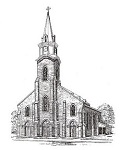The Assumption of Mary
By Scott P. Richert, About.com Guide
Introduction to the Assumption of Mary:
Celebrated every year on August 15, the Feast of the Assumption of the Blessed Virgin Mary commemorates the death of Mary and her bodily assumption into Heaven, before her body could begin to decay–a foretaste of our own bodily resurrection at the end of time. Because it signifies the Blessed Virgin’s passing into eternal life, it is the most important of all Marian feasts and a Holy Day of Obligation.
Quick Facts:
- Date: August 15.
- Type of Feast: Solemnity; Holy Day of Obligation. (For more details, see Is Assumption a Holy Day of Obligation?
- Readings: Revelation 11:19a, 12:1-6a, 10ab; Psalm 45:10, 11, 12, 16; 1 Corinthians 15:20-27; Luke 1:39-56 (full text here)
- Prayers: The Hail Mary
- Other Names for the Feast: The Solemnity of the Assumption of the Blessed Virgin Mary; The Assumption of Mary Into Heaven; The Dormition of the Theotokos; The Falling Asleep of the Blessed Virgin Mary
History of the Assumption:
The Feast of the Assumption is a very old feast of the Church, celebrated universally by the sixth century. The feast was originally celebrated in the East, where it is known as the Feast of the Dormition, a word which means “the falling asleep.” The earliest printed reference to the belief that Mary’s body was assumed into Heaven dates from the fourth century, in a document entitled “The Falling Asleep of the Holy Mother of God.” The document is written in the voice of the Apostle John, to whom Christ on the Cross had entrusted the care of His mother, and recounts the death, laying in the tomb, and assumption of the Blessed Virgin. Tradition variously places Mary’s death at Jerusalem or at Ephesus, where John was living.
The Assumption of the Blessed Virgin Mary into Heaven at the end of her earthly life is a defined dogma of the Catholic Church. On November 1, 1950, Pope Pius XII, exercising papal infallibility, declared in Munificentissimus Deus that it is a dogma of the Church “that the Immaculate Mother of God, the ever Virgin Mary, having completed the course of her earthly life, was assumed body and soul into heavenly glory.” As a dogma, the Assumption is a required belief of all Catholics; anyone who publicly dissents from the dogma, Pope Pius declared, “has fallen away completely from the divine and Catholic Faith.”
While the Eastern Orthodox believe in the Dormition, they object to the papal definition of the dogma, seeing it as unnecessary, since belief in Mary’s bodily assumption, tradition holds, goes back to apostolic times.
Pope Pius XII, in the text explaining his definition of the dogma of the Assumption, refers repeatedly to the Blessed Virgin’s death before her Assumption, and the consistent tradition in both the East and the West holds that Mary did die before she was assumed into Heaven. However, since the definition of the Assumption is silent on this question, Catholics can legitimately believe that Mary did not before the Assumption. (For more details on this question, see Did the Virgin Mary Die Before Her Assumption?.)


